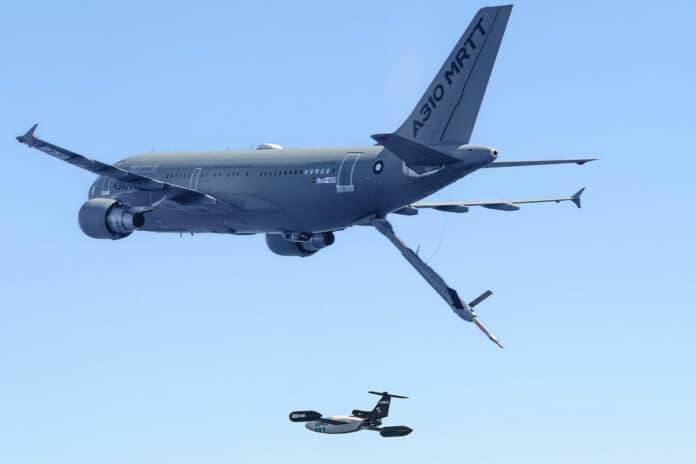Airbus Defence and Space and company subsidiary UpNext have achieved in-flight autonomous guidance and control of a drone using an A310 Multi-Role Tanker Transport (MRTT) flying testbed.
In another milestone on the road to fully Autonomous Formation Flight and Autonomous Air-to-Air Refueling (A4R), the technologies demonstrate a significant breakthrough for future aerial operations involving manned and unmanned assets. The trials were carried out last week in the south of Spain and lasted almost 12 hours in total.
Airbus is working on a set of technologies developed by Spain, Germany, and France called Auto’Mate. These cutting-edge technologies are designed to reduce crew fatigue and the potential for human error, as well as minimize crew training costs and provide more effective operations by automating the process.
The technologies were integrated on an A310 MRTT flying testbed and on several DT-25 target drones, acting as receiver aircraft – launched from Airbus’s Getafe plant and the Arenosillo test center in Huelva, respectively. Over the waters of the Gulf of Cadiz, the control of the drone transitioned from a ground station to the A310 MRTT, autonomously guiding the DT-25 to the in-flight refueling position. Each mission lasted 6 hours and involved the sequential launch of four DT-25s.
Thanks to artificial intelligence and cooperative control algorithms, the receivers were sequentially controlled and commanded during the tests without human interaction. The different receivers were controlled and guided until a minimum distance of 150 feet (around 45 meters) from the A310 MRTT.
The company says the Auto’Mate Demonstrator technology focuses on three pillars: accurate relative navigation – to determine precisely the relative position, speed, and attitudes between the tanker and the receiver; intra-flight communication between the platforms; and cooperative control algorithms for guidance and collision avoidance.
A second tranche of tests is expected towards the end of 2023, exploring the use of navigation sensors based on artificial intelligence and improved algorithms for autonomous formation flight. In addition, there will also be two simulated drones flying in the vicinity of the A310 MRTT to demonstrate multi-receiver autonomous operations and collision-avoidance technology.
“The success of this first flight-test campaign paves the way for developing autonomous and unmanned air-to-air refueling technologies,” said Jean Brice Dumont, Head of Military Air Systems at Airbus Defence and Space. “Even though we are at an early stage, we have achieved this within just one year and are on the right track for manned-unmanned teaming and future air force operations where fighters and mission aircraft will fly jointly with drone swarms.”
